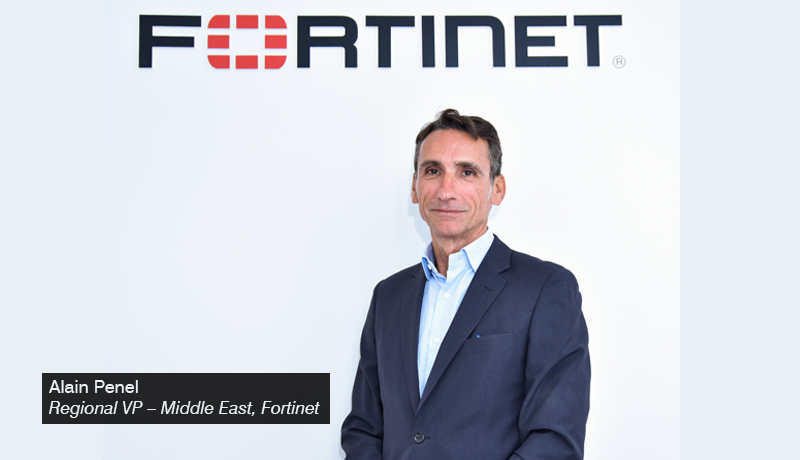
TECHx Executive Editor Rabab Zehra spoke with Alain Penel, Regional Vice President – Middle East, Fortinet, about the company’s children’s book, SD-WAN integration with Google Cloud Network Connectivity Center, remote working solutions, and channel partner initiatives. Let’s dig a little deeper into the responses we got.
TECHx: In March, Fortinet introduced a new children’s book designed to increase cyber awareness amongst children. Could you tell us how this initiative is going so far and plans going forward?
Alain Penel: With the continued onslaught of new devices on home networks linking students to teachers as well as to threat actors, cybercriminals continue to target remote work and learning to execute ransomware attacks, target devices to steal information, or compromise school security defenses. Younger kids are especially a vulnerable target for cybercriminals due to their lack of understanding of how cyber adversaries work and the detrimental impact of falling victim to these actors.
It remains very important for both parents and children especially as a new school year approaches, to focus on learning about basic cybersecurity best practices as many children continue in a hybrid capacity in various parts of the world. “Cyber Safe: A Dog’s Guide to Internet Security” is still as relevant as ever and continues to provide an easy to understand introduction to possible dangers for children connecting online for school, video games, streaming shows and more. It builds on Fortinet’s overall Training Advancement Agenda (TAA) initiatives focused on closing the cyber skills gap with broad cybersecurity awareness training, including NSE 1 and NSE 2 training courses which focus on basic cyber awareness and an overview of threat actors and their tactics. These two courses – part of the eight-level NSE Certification Program – are free for anyone interested and are for all ages including young children.
With a strong focus on seeding cybersecurity education at all levels, Fortinet hopes to continue to instill a strong foundation of cybersecurity at an early age in an effort to close the cyber skills gap and foster broad cybersecurity awareness knowledge.
TECHx: Fortinet recently announced SD-WAN integration to Google Cloud Network Connectivity Center. How has the rising migration to the cloud hastened the need for SD-WAN in enterprise networks?
Alain Penel: Increased cloud adoption has changed the digital landscape of organizations. Cloud offers agility, scalability, and access to leading-edge technology that is driving digital transformation journeys. The result is that over 90% of enterprises are operating across multiple and hybrid cloud environments that are now critical to their day-to-day operation. And with users and applications that may reside anywhere – from on-site to remote to data center to cloud – where these applications reside must be transparent to the end user. Organizations are then challenged to interconnect applications and data across clouds, data centers, and sites – sometimes at the expense of security and operational efficiency. This is where Secure SD-WAN comes into play.
Fortinet Secure SD-WAN combines award-winning security and SD-WAN technology in a single platform to help address these challenges. Customers reap the benefit of optimized connectivity, end-to-end security and superior user experience that is critical to operating in today’s diverse and distributed digital landscape. Whether on the cloud on-ramp, between clouds or in the cloud, combining resilience, security and high performance offers organizations a clear advantage in their digital journeys.
TECHx: Remote working is perhaps the most popular market trend right now. Many organizations now face significant difficulty in ensuring a secure cyber experience. What can be done about it, and what role does Fortinet play in this?Alain Penel:
Remote working or hybrid work environments is the future of work. While teleworks benefit due to the geographic freedom, the reduction in commute, and flexible schedule, there are also occasions in which remote work may be the only option for continued operations. The teleworker model has exposed users and companies up to a myriad of security threats including malware, all forms of phishing attacks and many more attacks. The Fortinet Security Fabric addresses remote worker scenarios with three primary levels of connectivity; For general users that require base level security, power users who spend more time accessing and using corporate networks, and super users who have elevated credentials or access to critical business information. With the Fortinet Security Fabric, the IT staff can manage the security architecture through a single pane of glass, even while working from home. With these existing solutions, Fortinet’s security team was well-positioned to facilitate new work-from-home policies without sacrificing the protection or performance of their users, applications, and data.
TECHx: How Fortinet empowers its channel partners in the face of a shifting business landscape?
Alain Penel: Today’s threat environment is constantly changing and taking a “security-driven networking” approach is crucial. Fortinet’s ‘security-driven networking’ strategy integrates an organization’s network and security architecture, allowing security to function as the key driver in business operations. By adopting a security-driven approach to networking, businesses can embrace digital innovation without exposing critical assets to risks.
By encouraging our partners to adopt security-driven networking, we are enabling them to offer customers greater levels of protection while growing their own businesses. Helping customers establish a security-driven networking strategy also gives partners a way to demonstrate value by providing guidance when addressing hybrid IT challenges. There are several reasons to adopt and recommend a converged security and networking approach that prioritizes a hybrid infrastructure, flexibility, and performance.
